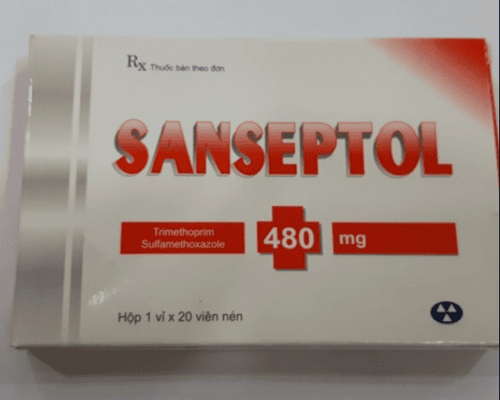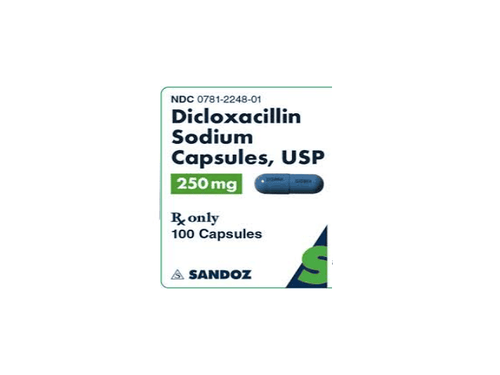This is an automatically translated article.
Sulfaprim is used in the treatment of diseases caused by bacteria such as acute and chronic bronchitis, sinusitis, otitis media, ... To ensure safety for health and maximize effectiveness As a result of treatment, patients need to take Sulfaprim exactly as directed by their doctor.
1. What is Sulfaprim?
Sulfaprim belongs to the group of drugs used to treat parasites, infections, viruses and fungi. The drug is prepared in the form of tablets, packing specifications: Box of 10 blisters x 10 long tablets.Sulfaprim medicine contains the following ingredients:
Active ingredient Sulfamethoxazol 400mg; Active ingredient Trimethoprim 80mg; Excipients just enough for 1 tablet: Tapioca and corn starch, Methyl hydroxybenzoate, Magnesium stearate, Ethanol 96%, Propyl hydroxybenzoate. With the active ingredient Sulfamethoxazol, this is an antibiotic belonging to the Sulfamide group with a broad antibacterial spectrum. Sulfamethoxazole kills bacteria by inhibiting the synthesis of folic acid. Sulfamethoxazole competes with para aminobenzoic acid to hinder the bacterial conversion of para aminobenzoic acid to folate by the enzyme dihydropteroate synthetase. Sulfamethoxazole is effective against many bacteria such as gram-negative bacilli, gonorrhea, staphylococci, dysentery bacilli. And Trimethoprim is a derivative of Pyrimidine that has the ability to specifically inhibit the enzyme dihydrofolate reductase in bacteria. Similar to Sulfamethoxazol, Trimethoprim kills bacteria by inhibiting the synthesis of folic acid by bacteria. Trimethoprim is often indicated in the treatment of urinary tract infections associated with bacteria such as E. coli bacilli, Klebsiella gram-negative bacilli, Staphylococcus saprophyticus, enterobacteriaceae.
2. Indications for taking the drug Sulfaprim
Sulfaprim is indicated in the treatment of diseases caused by strains of bacteria sensitive to Sulfamethoxazole and Trimethoprim. The drug works with infections related to the respiratory tract, digestive tract, urinary tract, genitals such as:
Urethritis with or without complications. Infectious prostatitis. Inflammation of the upper respiratory tract such as sinusitis, otitis media. Inflammation of the lower respiratory tract such as: Pneumonia, acute exacerbation of chronic bronchitis. Gastrointestinal infections caused by bacillus dysentery and typhoid.
3. Dosage, how to use Sulfaprim
Sulfaprim dose in adults:
Treatment of urinary tract infections in adults: Take 4 Sulfaprim tablets 2 times a day, 12 hours apart. 10 day course of treatment. Treatment of respiratory infections: Take 2-3 times a day, 1-2 tablets each time. Treatment regimen for 10 days. Gastrointestinal infections: Take 1-2 tablets of Sulfaprim each time, take 2 times a day and treat for 5 days. Dosage of Sulfaprim in Children:
Dosage of Sulfaprim in children depends on body weight. Dosage can be calculated according to the following formula: 8mg of Trimethoprim and 40mg of Sulfamethoxazole per kg of body weight, divided into 2 oral doses, each time about 12 hours apart. Dosage in patients with renal impairment:
If creatinine clearance > 30ml per minute can be used according to the usual dose of Sulfaprim. If creatinine clearance is in the range of 15-30ml per minute, use only 1/2 of the normal dose. In cases where the patient's creatinine clearance is < 15 ml per minute, treatment with Sulfaprim should not be recommended. How to use Sulfaprim:
Patients should take Sulfaprim with food or with plenty of water to minimize the adverse effects of the drug on the gastrointestinal tract. Note: The above dose of Sulfaprim is for reference only. The specific dose of Sulfaprim will depend on your condition and disease progression. To get the right dose of Sulfaprim, patients need to consult their doctor/pharmacist.
4. Contraindications to taking Sulfaprim
Do not use Sulfaprim to treat people with one of the following conditions:
Hypersensitivity to the active ingredients Sulfamethoxazole and Trimethoprim or any of the excipients in the drug Sulfaprim. The patient has severe renal failure. Children under 2 years old. Megaloblastic anemia is caused by folic acid deficiency.
5. Side effects of the drug Sulfaprim
Sulfaprim may cause some side effects for users such as:
Common symptoms: Fever, nausea and vomiting, itching, skin rash. Less common symptoms: Decrease in the number of neutrophils, platelets. Rare reactions: Megaloblastic anemia, hemolytic anemia, hallucinations, meningitis, renal failure, interstitial nephritis, nephrolithiasis. During the course of treatment, if there are any abnormal symptoms suspected of using Sulfaprim, the patient should notify the treating doctor/pharmacist for timely treatment.
6. Interactions with other drugs
Sulfaprim can interact with some other drugs when used concurrently as follows:
Concomitant use of Sulfaprim with anticoagulants will prolong prothrombin time in patients. The risk of megaloblastic anemia is increased if Sulfaprim is taken while taking pyrimethamine 25mg a week. Sulfaprim is capable of and excessively potentiating the effects of Phenytoin. In addition, Sulfaprim interacts with some other drugs such as: Methotrexate, Cyclosporin, hypoglycemic drugs, non-steroidal anti-inflammatory drugs. In order to avoid unwanted interactions when using Sulfaprim, patients should inform their doctor/pharmacist of all drugs, supplements, vitamins... they are taking.
7. Precautions when using Sulfaprim and proper storage
Use caution when using Sulfaprim in the following cases:
Patients with impaired renal function. If taking Sulfaprim for a long time, close monitoring is necessary to control folic acid deficiency, especially in the elderly. Sulfaprim can cause dehydration, malnutrition, and hemolytic anemia in people with G6PD deficiency. Store Sulfaprim:
Keep Sulfaprim in a cool, dry place, away from direct sunlight. In short, Sulfaprim is a combination of two antibiotics Trimethoprim and Sulfamethoxazol, which works to increase the effectiveness of treatment, limit the resistance of bacteria. . To ensure safety for your health and maximize the effectiveness of your treatment, you need to take Sulfaprim exactly as directed by your doctor.













